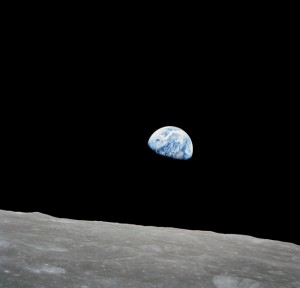Earthrise
“The most influential photograph ever taken”
For many years, the question of who actually took the famous image was a source of joking between the three Apollo 8 crew members. Frank Borman was adamant that he had taken the first Earthrise, but the mission transcripts pointed to Anders. Eventually, historians researched deeper into transcripts from the mission and were able to determine what happened, and who took the photo.
Without a Lunar Module to fly, Bill Anders was assigned to photograph targets on the moon. Tuesday morning, he had completed 40 minutes of photography and at 3 days, 3 hours and 47 minutes into the mission, Col. Borman was repositioning Apollo 8 for a navigational sighting. As he looked out the window to begin the maneuver, the onboard tape recorder recorded that he suddenly exclaimed “Oh my God! Look at that picture over there! Here’s the earth coming up! Wow, is that pretty.”
Jim Lovell looked out and replied “Oh man, that’s great!”
Borman grabbed the floating camera Anders had been using and took the first Earthrise photo, but the camera was loaded with black and white film. Anders took the camera and called “Hand me that roll of color quick,” to Jim Lovell, who was near the film locker.
As Anders wrestled to load the film magazine Lovell called that he had a clear view from another window, but Anders had the camera and also a good view. As Anders carefully framed the image both Borman and Lovell encouraged him to take several images.
For photographers, Bill used a modified Hasselblad 500 EL camera with a 70 mm lens exposed for 1/250 at f:11, with the added difficulty factor of Jim Lovell breathing down his neck.
After taking 2 shots Lovell asked “You sure we got it now?” to which Anders dryly replied “It’ll come up again, I think,” referring to the seven more lunar orbits Apollo 8 was scheduled to make.
Over the years, the photo has been reproduced on stamps, posters and in many books. The great photographer Galen Rowell called it “the most influential environmental photograph ever taken” and many have called it the photo that jump started the environmental movement.
Which way is up?
 We normally think of the earth as being “up” with the north pole on top and the south pole on the bottom. However, in space there is no gravity and no up or down.
We normally think of the earth as being “up” with the north pole on top and the south pole on the bottom. However, in space there is no gravity and no up or down.
The graphic on the right shows (with the clouds removed) what part of the earth you see in the Earthrise image.
Notice that when zoomed in and with the clouds removed, the north pole is on the right side of the image and the earth looks a little odd laying on its side. The west side of Africa and the Cape of Good Hope are visible at the bottom. The white ice of Antarctica is also visible, but the white ice blends in with the clouds. And if you look closely you can even see the reflection of the sun in the Atlantic Ocean.
So which way is right? Purists like the image with the north pole of the earth on top. Many like the image the way it is often published, with the earth laying “on it’s side”, rising over the moon.
“We came all this way to explore the moon, and the most important thing is that we discovered the Earth” ~ Bill Anders
Credits
Thanks to HFM Volunteer Steve Kessinger for researching & writing this material


